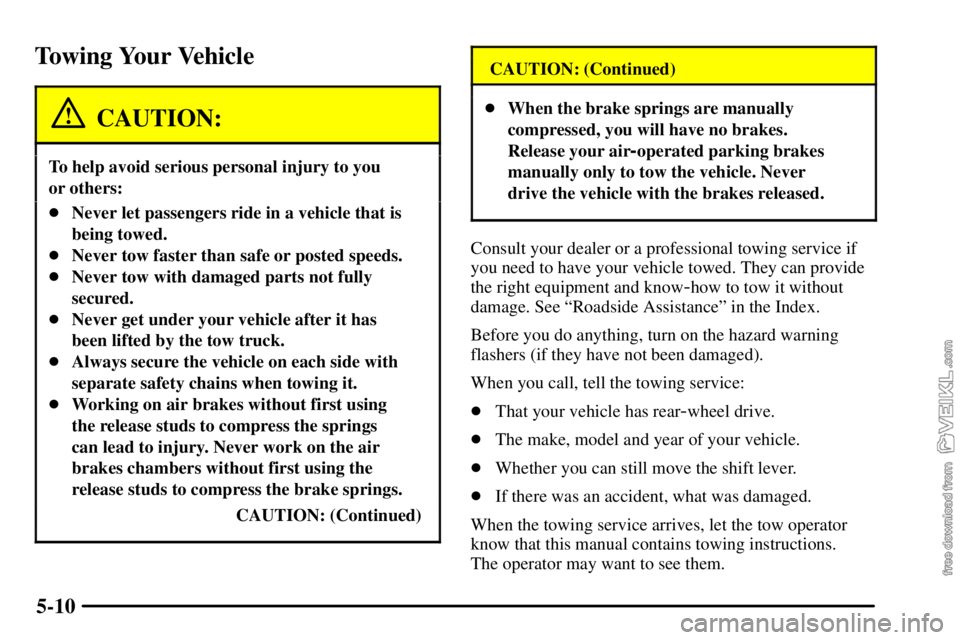Page 216 of 386

4-23
Reduce your speed according to your speedometer, not
to your sense of motion. After driving for any distance
at higher speeds, you may tend to think you are going
slower than you actually are.
Highway Hypnosis
Is there actually such a condition as ªhighway
hypnosisº? Or is it just plain falling asleep at the
wheel? Call it highway hypnosis, lack of awareness,
or whatever.
When you drive the vehicle for a long distance, there is
something about an easy stretch of road with the same
scenery, along with the hum of the tires on the road, the
drone of the engine, and the rush of the wind against the
vehicle that can make you sleepy. Don't let it happen to
you! If it does, your vehicle can leave the road in less
than a second, and you could crash and be injured.What can you do about highway hypnosis? First, be
aware that it can happen.
Then here are some tips:
�Make sure your vehicle is well ventilated, with a
comfortably cool interior.
�Keep your eyes moving. Scan the road ahead and to
the sides. Check your mirrors and your instruments
frequently.
�If you get sleepy, pull off the road into a rest, service
or parking area and take a nap, get some exercise, or
both. For safety, treat drowsiness on the highway as
an emergency.
Page 221 of 386

4-28
If you don't have a traction system, accelerate gently.
Try not to break the gentle traction. If you accelerate too
fast, the drive wheels will spin and polish the surface
under the tires even more.
�Whatever your braking system, allow greater
following distance on any slippery road.
�Watch for slippery spots. The road might be fine
until you hit a spot that's covered with ice. On an
otherwise clear road, ice patches may appear in
shaded areas where the sun can't reach: around
clumps of trees, behind buildings or under bridges.
Sometimes the surface of a curve or an overpass may
remain icy when the surrounding roads are clear. If
you see a patch of ice ahead of you, brake before you
are on it. Try not to brake while you're actually on
the ice, and avoid sudden steering maneuvers.If You're Caught in a Blizzard
If you are stopped by heavy snow, you could be in a
serious situation. You should probably stay with your
vehicle unless you know for sure that you are near help
and you can hike through the snow. Here are some
things to do to summon help and keep yourself and your
passengers safe:
�Turn on your hazard flashers.
Page 235 of 386

5-10
Towing Your Vehicle
CAUTION:
To help avoid serious personal injury to you
or others:
�Never let passengers ride in a vehicle that is
being towed.
�Never tow faster than safe or posted speeds.
�Never tow with damaged parts not fully
secured.
�Never get under your vehicle after it has
been lifted by the tow truck.
�Always secure the vehicle on each side with
separate safety chains when towing it.
�Working on air brakes without first using
the release studs to compress the springs
can lead to injury. Never work on the air
brakes chambers without first using the
release studs to compress the brake springs.
CAUTION: (Continued)
CAUTION: (Continued)
�When the brake springs are manually
compressed, you will have no brakes.
Release your air
-operated parking brakes
manually only to tow the vehicle. Never
drive the vehicle with the brakes released.
Consult your dealer or a professional towing service if
you need to have your vehicle towed. They can provide
the right equipment and know
-how to tow it without
damage. See ªRoadside Assistanceº in the Index.
Before you do anything, turn on the hazard warning
flashers (if they have not been damaged).
When you call, tell the towing service:
�That your vehicle has rear
-wheel drive.
�The make, model and year of your vehicle.
�Whether you can still move the shift lever.
�If there was an accident, what was damaged.
When the towing service arrives, let the tow operator
know that this manual contains towing instructions.
The operator may want to see them.
Page 236 of 386

5-11
Here are specific towing instructions:
Towing Your Vehicle From the Front
(Front Wheels Off the Ground)
Before Towing
Block the rear wheels of the disabled vehicle. On
vehicles with air brakes, release the emergency brake
system by compressing the brake chamber springs
as outlined in this section. (This is to prevent the
possibility of the emergency brake being applied
during towing.)
On vehicles with hydraulic brakes, release the parking
brake fully by moving the lever to the fully
-released
position.
Disconnect the propshaft at the rear axle (forward axle
on tandem axle models). Secure the propshaft to the
frame or crossmember.
Towing the Vehicle with the Front Bumper Removed
1. Remove the front bumper.
2. Connect and lock the lift chains to the front axle,
outside of the spring anchor plates as shown.
A. Spring Anchor Plate
B. Lift Chain
C. Front Axle
3. Place a 6º x 6º x 5' hardwood beam underneath and
slightly behind the front spring shackle brackets.
4. Connect the lift chains to the tow bar and raise the
tow bar until lift chain slack has been taken up and
the hardwood beam is fully seated against the spring
shackle brackets as shown.
Page 239 of 386
5-14
Single Drive Rear Axle
Disconnect the propshaft at the rear axle. Secure the
propshaft to the frame or crossmember.
Tandem Drive Rear Axles
(Forward Axle Off the Ground)
Raise the front of the vehicle until the forward tandem
axle wheels are off the ground. Remove the rearward
propshaft.Tandem Drive Rear Axle (Both Axles on the Ground
Due to Type of Suspension or Attached Load)
Disconnect the propshaft at the forward tandem axle.
Secure the propshaft to the frame or crossmember.
If there is damage or suspected damage to the axle(s),
remove all axle shafts. Cover the hub openings to
prevent the loss of lubricant or entry of dirt or
foreign objects.
After Towing
1. Block the rear wheels and install axle and propshafts.
2. Check for proper phasing of universal joints.
3. Apply the emergency brake system before
disconnecting from the towing vehicle.
Page 240 of 386

5-15 Towing Your Vehicle From the Front
(All Wheels On the Ground)
Your vehicle may be towed on all wheels provided the
steering is working. Remember that the power brakes
and power steering will not have power assist. Vehicles
with air brakes will not have brakes. There must be a
tow bar installed between the towing vehicle and the
disabled vehicle.
Before Towing
Block the wheels of the disabled vehicle. On vehicles
with air brakes, release the emergency brake system by
compressing the brake chamber springs as outlined in
this section. (This is to prevent the possibility of the
emergency brake being applied during towing.)
On vehicles with hydraulic brakes, release the parking
brake fully by moving the lever to the fully
-released
position.
Disconnect the propshaft at the rear axle (forward axle
on tandem axle models). Secure the propshaft to the
frame or crossmember.
If there is damage or suspected damage to the axle(s),
remove the axle shafts. Cover the hub openings to
prevent the loss of lubricant or entry of dirt or
foreign objects.After Towing
1. Block the rear wheels and install axle and propshafts.
2. Check for proper phasing of universal joints.
3. Apply the parking brake system before
disconnecting from the towing vehicle.
4. Check and fill with oil as required.
Towing Your Vehicle From the Rear
Before Towing
Secure the steering wheel to maintain a straight
-ahead
position. Make certain that the front axle is not loaded
above the front axle Gross Axle Weight Rating (GAWR)
as indicated on the vehicle's Gross Vehicle Weight
Rating (GVWR) label. See ªGross Vehicle Weight
Rating (GVWR)º in the index for more information.
After Towing
Block the rear wheels and release the steering. Apply the
parking brake system before disconnecting from the
towing vehicle.
Refer to the transmission shift label for additional
information.
Page 241 of 386
5-16 Releasing Air-Operated Parking Brakes
(If Equipped)
If your vehicle has air brakes, you could have a special
towing problem. If your vehicle has to be towed because
of a complete loss of air pressure from both systems, the
parking brakes will have automatically engaged. The
tow operator can release the brakes manually by using
the following steps. Then your vehicle can be towed
with all wheels or only the rear wheels on the ground.
1. Block the wheels of the vehicle.
2. Remove the release stud and nut from the side of the
brake chamber. Some chambers have studs which are
visible at all times.
3. Remove the rubber
cap from the rear of
the chamber.
4. Put the release stud, nut and flat washer into
the chamber.
5. Turn the stud clockwise a quarter of a turn.
Page 251 of 386

5-26
Engine Fan Noise
Your vehicle has a clutched engine cooling fan. When
the clutch is engaged, the fan spins faster to provide
more air to cool the engine. In most everyday driving
conditions, the clutch is not fully engaged. This
improves fuel economy and reduces fan noise. Under
heavy vehicle loading, trailer towing and/or high outside
temperatures, the fan speed increases when the clutch
engages. So you may hear an increase in fan noise.
This is normal and should not be mistaken as the
transmission slipping or making extra shifts. It is merely
the cooling system functioning properly. The fan will
slow down when additional cooling is not required and
the clutch disengages.
You may also hear this fan noise when you start the
engine. It will go away as the fan clutch disengages.
If a Tire Goes Flat
It's unusual for a tire to ªblow outº while you're driving,
especially if you maintain your tires properly. If air goes
out of a tire, it's much more likely to leak out slowly.
But if you should ever have a ªblowout,º here are a few
tips about what to expect and what to do:
If a front tire fails, the flat tire will create a drag that
pulls the vehicle toward that side. Take your foot off the
accelerator pedal and grip the steering wheel firmly.
Steer to maintain lane position, and then gently brake to
a stop well out of the traffic lane.
A rear blowout, particularly on a curve, acts much like a
skid and may require the same correction you'd use in a
skid. In any rear blowout, remove your foot from the
accelerator pedal. Get the vehicle under control by
steering the way you want the vehicle to go. It may be
very bumpy and noisy, but you can still steer. Gently
brake to a stop
-- well off the road if possible.
If a tire goes flat, avoid further tire and wheel damage
by driving slowly to a level place and turn on your
hazard warning flashers. The next part tells you what
to do.